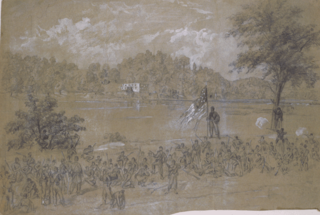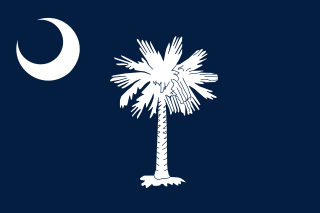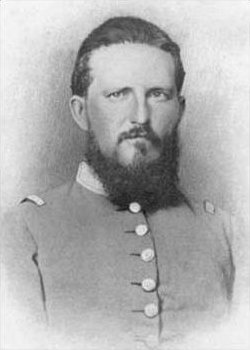
The Second Battle of Bull Run or Battle of Second Manassas was fought August 28–30, 1862, in Prince William County, Virginia, as part of the American Civil War. It was the culmination of the Northern Virginia Campaign waged by Confederate Gen. Robert E. Lee's Army of Northern Virginia against Union Maj. Gen. John Pope's Army of Virginia, and a battle of much larger scale and numbers than the First Battle of Bull Run fought on July 21, 1861, on the same ground.

The First Battle of Bull Run, called the Battle of First Manassas by Confederate forces, was the first major battle of the American Civil War. The battle was fought on July 21, 1861, in Prince William County, Virginia, just north of the city of Manassas and about thirty miles west-southwest of Washington, D.C. The Union Army was slow in positioning themselves, allowing Confederate reinforcements time to arrive by rail. Each side had about 18,000 poorly trained and poorly led troops. The battle was a Confederate victory and was followed by a disorganized post-battle retreat of the Union forces.

The Battle of New Market was fought on May 15, 1864, in Virginia during the Valley Campaigns of 1864 in the American Civil War. A makeshift Confederate army of 4,100 men defeated the larger Army of the Shenandoah under Major General Franz Sigel, delaying the capture of Staunton by several weeks.

The First Battle of Kernstown was fought on March 23, 1862, in Frederick County and Winchester, Virginia, the opening battle of Confederate Maj. Gen. Thomas J. "Stonewall" Jackson's campaign through the Shenandoah Valley during the American Civil War.

The Battle of Cross Keys was fought on June 8, 1862, in Rockingham County, Virginia, as part of Confederate Army Maj. Gen. Thomas J. "Stonewall" Jackson's campaign through the Shenandoah Valley during the American Civil War. Together, the battles of Cross Keys and Port Republic the following day were the decisive victories in Jackson's Valley Campaign, forcing the Union armies to retreat and leaving Jackson free to reinforce Gen. Robert E. Lee for the Seven Days Battles outside Richmond, Virginia.

The Battle of Shepherdstown, also known as the Battle of Boteler's Ford, took place September 19–20, 1862, at Boteler's Ford along the Potomac River, during the Maryland campaign of the American Civil War. After the Battle of Antietam on September 17, General Robert E. Lee and the Confederate Army of Northern Virginia withdrew across the Potomac. Lee left a rear guard commanded by Brigadier General William N. Pendleton at Boteler's Ford. On September 19, elements of the Union V Corps dueled with Pendleton's artillery before pushing a short distance across the river at dusk. Pendleton inaccurately informed Lee that all of the artillery of the rear guard had been captured. On the morning of September 20, the Confederates counterattacked with A. P. Hill's Light Division, forcing the Union units back across the Potomac. One Union unit, the 118th Pennsylvania Infantry Regiment, did not withdraw at the same time as the others and suffered heavy losses. Lee's army continued its retreat into the Shenandoah Valley after the battle.
The Stonewall Brigade of the Confederate Army during the American Civil War, was a famous combat unit in United States military history. It was trained and first led by General Thomas J. "Stonewall" Jackson, a professor from Virginia Military Institute (VMI). His severe training program and ascetic standards of military discipline turned enthusiastic but raw recruits into an effective military organization, which distinguished itself from the First Battle of Bull Run in 1861 to Spotsylvania Court House in 1864. Its legacy lives on in the 116th Infantry Brigade, which bears the unofficial nickname "Stonewall Brigade," and in several living history reenactment groups.

John McCausland, Jr. was a brigadier general in the Confederate army, famous for the ransom of Hagerstown, Maryland, and the razing of Chambersburg, Pennsylvania, during the American Civil War.

The Army of the Shenandoah was a field army of the Confederate States Army active during the American Civil War. It was created to defend the Shenandoah Valley of Virginia from Union Army attacks during the early months of the war. The army was transferred to reinforce the Confederate Army of the Potomac at the First Battle of Bull Run, which was the only major engagement of the war it participated in. After the battle, the army was merged into the Army of the Potomac.

The 33rd Virginia Infantry Regiment was an infantry regiment raised in the Commonwealth of Virginia for service in the Confederate States Army during the American Civil War. It was a part of the famed "Stonewall Brigade," named for General Stonewall Jackson.

Hampton's Legion was an American Civil War military unit of the Confederate States of America, organized and partially financed by wealthy South Carolina planter Wade Hampton III. Initially composed of infantry, cavalry, and artillery battalions, elements of Hampton's Legion participated in virtually every major campaign in the Eastern Theater, from the first to the last battle.

William Thomas Poague was a Confederate States Army officer serving in the artillery during the American Civil War. He later served as Treasurer of the Virginia Military Institute.

Elisha Franklin Paxton was an American lawyer and soldier who served as a Confederate brigadier general during the American Civil War. He died while leading the “Stonewall Brigade“ during the Battle of Chancellorsville.

Alexander Swift Pendleton was an officer on the staff of Confederate Generals Thomas J. Jackson, Richard S. Ewell and Jubal A. Early during the American Civil War.

The 27th Virginia Infantry Regiment was an infantry regiment raised in Virginia for service in the Confederate States Army during the American Civil War. It fought mostly with the Stonewall Brigade of the Army of Northern Virginia.

The 2nd Virginia Infantry Regiment was an infantry regiment raised in today's western Virginia and what became West Virginia during the American Civil War for service in the Confederate States Army. It would combine with the 4th, 5th, 27th, and 33rd Virginia infantry regiments and the Rockbridge Artillery Battery and fight as part of what became known as the Stonewall Brigade, mostly with the Army of Northern Virginia.

The 4th Virginia Volunteer Infantry Regiment was an infantry regiment raised in southwestern Virginia for service in the Confederate States Army during the American Civil War. It fought in the Stonewall Brigade, mostly with the Army of Northern Virginia. Though it suffered heavy losses, two surviving officers resumed political careers after the conflict and won election to the U.S. House of Representatives, and several more served in the Virginia General Assembly.
Carpenter's Battery, also known as Alleghany Artillery or Alleghany Rough Artillery, was a famed Confederate artillery battery unit in the American Civil War. The unit was first organized at Covington, Virginia on April 20, 1861 as Company A of the 27th Virginia Infantry Regiment, the "Alleghany Roughs." When the Captain who organized the company resigned due to ill health, the captaincy devolved upon his First Lieutenant, Joseph Hannah Carpenter, who was born in 1834 at Covington, Virginia, in Alleghany County, Virginia. Carpenter had been an artillery cadet under General Thomas J. "Stonewall" Jackson in the class of 1858 at Virginia Military Institute and legend has it that General Jackson recognized his former student's name on the company muster roll and ordered the company converted to an artillery battery with Carpenter as its captain, thus becoming "Carpenter's Battery."

The Wise Artillery was an artillery unit with the Confederate States Army during the American Civil War.

Independent Battery F, Pennsylvania Light Artillery, also known as the "Pittsburg Battery", was an artillery battery that served in the Union Army during the American Civil War. Organized in December 1861, the unit first served in the Shenandoah Valley. Battery F fought at Hancock, Winchester, Sulphur Springs, Second Bull Run, Chantilly, and Antietam in 1862. The following year the unit fought at Chancellorsville, Gettysburg, the Bristoe Campaign, and Mine Run. In 1864–1865, Battery F fought at Morton's Ford and served in the garrisons of Washington, D.C., and Harper's Ferry, West Virginia before being mustered out in June 1865. One enlisted man from the battery won the Medal of Honor for heroic action at Gettysburg.















